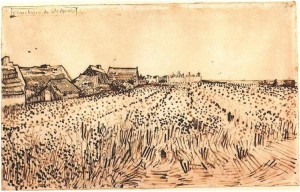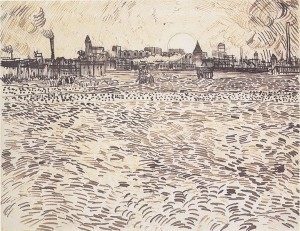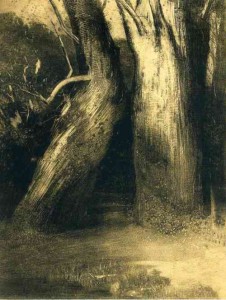Just Draw! Part 3: Outdoors
April 30, 2015

Above: One of my sketches in an A5 sketchbook using inks, pencils, watercolours and pens, 2010
Countryside and urban landscape are full of inspiration for the artist. Here in the UK, days are lengthening and weather is (sometimes) dry, so this is a great time to consider heading outdoors to draw.
A few practicalities
To get started, you really only need a sketchbook (or other drawing paper) and a pen or pencil. However, I suggest packing a few other bits and pieces to keep you comfortable during your drawing session:
- A lightweight folding stool or chair so that you won’t be restricted to drawing from park benches, etc. if you prefer to draw while seated.
- Layered clothing appropriate to the weather
- Snacks and hot or cold drinks to keep you going
- Rucksack to carry your stuff- you may choose to walk quite a distance between stopping to draw.
- If you wish, a few printed images of inspiring drawings (or download them onto a mobile)
- Tissues and/or wipes for clean-up
- A portable easel is optional, but is particularly useful if drawing on a larger scale.
You may also like to bring a variety of art materials. Here are some suggestions:
- Either a sketchbook or a drawing board plus bulldog clips and loose sheets of various papers
- A few ballpoint, marker and/or nibbed pens
- A few sticks of charcoal and chalk and a putty rubber (this works well with toned paper). Charcoal smudges, so bring greaseproof/parchment paper with which to protect your work on the way home if required. Also do remember wipes for clean-up.
- A little watercolour pan set plus either a water-brush or a normal brush plus screw-top container of water
- A pot of ink (brown is lovely) plus water for clean-up, and a dip pen plus one or more nibs. For ink and wash techniques, also bring a brush and one or more little containers in which you can dilute the ink.
- A graphite stick
- Pencils (coloured or otherwise) plus a good sharpener and a bag or container for any pencil-sharpenings.
Possibilities for outdoor drawing are limitless. Here are a few ideas to get you started:
A broad landscape showing the lie of the land
Above: Vincent van Gogh drawing in pencil, reed pen and brown ink, c1888
Medium: Pen and ink on cartridge-type paper. A ballpoint, cartridge or marker pen are fine. For more characterful lines, try a nibbed dip pen or reed pen plus a bottle of ink. You’ll also need an HB or 2B pencil for a little light under-drawing.
Subject: Any landscape or cityscape in which your view is not obstructed by nearby trees or buildings.
Looking at the subject: Can you see the foreground, middle distance and far distance? Remember that, whether you choose to sit or stand while drawing, the horizon-line will be at you eye level. Can you see any part of the horizon, or do buildings or trees entirely obscure it? Is the ground flat, or does it slope one way or the other? Decide how much of the view you’d like to include in your drawing.
 Above: Three drawings by Vincent van Gogh (1853-1890)
Above: Three drawings by Vincent van Gogh (1853-1890)
The drawing: In this drawing, you’ll aim to convey a general sense of the “lie of the land” (US: “lay of the land”), i.e. its hilliness or flatness, and a sense of distance. Textures of surfaces can also be suggested.
Start with a few light pencil marks on your page to show where the important bits of the landscape are to be positioned in your drawing. These pencil marks can be erased or forgotten once you have drawn in pen over the top of them. I suggest marking a faint horizontal line across the page to show the level of the horizon. Also use your pencil to indicate where any buildings, hedges, paths are to go. Try to indicate with your pencil the position of slopes in the ground, if any are present.
Now tackle the drawing with pen. I suggest an approach similar to that used by Vincent van Gogh in many of his drawings. Work across the landscape, using whichever pen marks you choose (dots, sweeping strokes, etc.) to suggest the slope or direction of the land and the texture of the surface. Keep your pen marks lively. We are not trying to convey the effects of light here, so laborious cross-hatching or shading are not required.
Pen marks should tend to get smaller as they disappear into the distance in your picture. They may also converge into the distance, e.g. if suggesting rows of corn or edges of a path leading into the picture. This helps to give your picture a sense of distance.
Taking this idea further: You may wish to develop this idea by drawing in colour. Feel free to use the same linear style as described above, this time working in coloured inks, coloured pens or pencils. If you wish, you may choose colours to help emphasise a sense of distance (cool colours tend to recede, while warm ones come forward). Your colours may be based on those of the landscape itself, or you may opt for a more experimental approach, with colour providing a sense of emotion.
Above: David Hockney, pages from a Yorkshire Sketchbook, c.2004
Like David Hockney (see image above), you could add in blocks of painted colour if you wish. Several of Hockney’s landscape sketches have a similar “lie of the land” approach to those of van Gogh, with an emphasis on distance and topographical features of the landscape, plus touches of surface texture.
A tonal approach to trees
Above: Claude Lorrain “A group of trees on a riverbank” c1640-45, brown ink with underlying black chalk
When the evening light is fading, have a go at drawing the silhouetted shapes formed by trees. These could be very quick, fleeting sketches suggesting the general shape of the tree masses. Charcoal, graphite or brush with ink are all ideal for sketching simple trees, or you could block them in using pen or soft pencil. Try doing several little sketches of different trees (or groups of trees) across a double-page spread of your sketchbook before the sun completely disappears.
Trees do of course form tonal shapes at any time of the day. Look at them with screwed-up eyes to emphasise this effect.
For a more finished drawing, as in Lorrain’s image of trees, above, look out for any more subtle variations in tone. As a whole, the trees and the ground that they stand on may be much darker than the sky behind. However, a closer look reveals some parts to be a deep, almost black shadow, while other parts are lighter in tone.
Above: Odilon Redon “Deux Arbres” 1875
Tone can have quite an emotional impact (for example, see the image by Redon, above). When you are exploring woodland, other countryside or urban areas, keep an eye out for those unexpected dark shadows or startling contrasts that make you look twice.
Trees with character
Each tree has its own unique structure depending not only on its species but also on its history, the prevailing wind and so on. They are just as worthwhile to draw as a human or animal figure though, of course, they will neither walk away nor charge you by the hour.
Drawing trees can be approached in a similar manner to life drawing. Just as when drawing the human figure, it helps to check proportions with care:
- Check, for example, whether it is taller than it is wide.
- At which point off the trunk do the lowest branches emerge – a half, a third or a quarter of the way up?
- Do the branches reach up almost vertically to the sky, do they stretch out horizontally, or do they branch off from the trunk at an angle?

Above: George Ernest Papendiek (1788-1835) “The Lebanon Cedar Tree in the Arboretum at Kew Gardens”
The general structure of the tree should be drawn out before considering adding small details. If attempting to draw the entire tree, do step back far enough so that you can see the entire structure without moving your head, even if this means working from the opposite end of the field.
A few ideas for drawing individual trees:
1) In graphite, pencil or pen. Using the whole double-page spread of your sketchbook, sketch the tree very rapidly using a continuous-line technique, i.e. do not lift your drawing tool off the paper form start to finish. You should end up with a flowing image with an intuitive quality.
2) In pencil, charcoal or graphite, use a more careful, structural approach to drawing a tree. Work much more slowly (e.g. over a period of 40-60 minutes). Make multiple measurements using your outstretched arm to check the proportions of trunk, main branches and masses of foliage, and estimate angles of the main branches. Use the tip of your charcoal or graphite stick to draw edges in once you have worked out where they should go. As you build this drawing up, turn the charcoal or graphite on its side to block in regions of dark tone if you wish.
3) In any medium of your choice, draw from the tree using a mixture of careful measuring marks and more intuitive, flowing lines. A tree that is growing at an unusual angle is a good one to draw to start with. Leave about 30 minutes for this drawing as it is better left uncompleted than overworked. I suggest starting by making a few measurements and checking how your tree will fit onto your paper. Work into the drawing more boldly to emphasise the direction of the trunk and branches and perhaps to suggest movement if it is a windy day.
Above: Eugene Delacroix “Study of an Oak”, graphite on wove paper, 21 x 33.8cm, 1857






